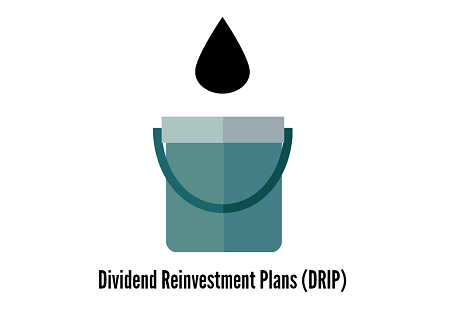Why I like Dividend Reinvestment Plans (DRIP)
Part of my retirement portfolio includes individual stocks and several of them pay dividends quarterly. The online trading platform I use gives several options on what to do with these dividends. The money gained from dividends can be either reinvested in the company automatically (Hence the name dividend reinvestment plan / DRIP) or deposited into a savings account. Having dividends automatically reinvested can benefit a retirement portfolio by adding compounding returns to an individual stock.
Advantages to entering into a DRIP
Acquire more stock commission free
Each time I make a trade I have to pay a commission to the financial institution I am utilizing. This fee becomes quite costly if either trading low sums of money or trading stocks frequently.
With a DRIP the cash dividends are reinvested in the stock commission free at many institutions, including the one I use. This means that each quarter instead of getting more money in my savings account to do as I please, I automatically get more shares commission free. Then the next quarter I get dividends on all the shares I own, including the ones obtained via the DRIP. Over time, the compounding interest that this builds up accelerates dividend rewards.
For companies that I wish to hold long term, greater than 5 years, I like DRIP since it builds wealth in companies that I have no desire to trade for short term market fluctuations.
An example of a stock that I used this for is Ford. I have owned Ford stock for several years and noticed that in my first year I had a total of 9 shares bought with DRIP. Last year I accumulated 12 extra shares via the drip method, all done commission free. Since I plan to keep my Ford stock long term, then at the end of this year I should accumulate even more shares of the stock assuming ford does not change dividend distributions.
Discounted stock
My institution does not provide this type of service but I have read of others that offer cash purchase of additional shares of stock directly from the company at a slight discount.
Dollar cost averaging
Since dividends are reinvested each quarter, extra shares will be obtained potentially each quarter. For those in favor of dollar cost averaging, this spreads out stock distribution to potentially 4 times a year and not all at once.
Disadvantages to DRIP
If the amount of dividends paid each quarter does not equal at least the value of buying one share of the stock then the money sits in a spreadsheet building no interest. The money will remain in a holding account, not building interest until there is enough money built up to purchase at least one share after distributing dividends each quarter.
In situations such as this, it may be better to take the money and use it for other means. Leaving the money in a holding account will allow your trading platform to basically have an interest free loan.
Changing assert allocation
If left on autopilot DRIP can disproportionately add to one type of investment, increasing its overall percent of ones asset allocation. There needs to be at least yearly evaluations of retirement assets to ensure that asset allocation states at a level that you find acceptable.
Fees
Some financial institutions will charge fees for a DRIP. Be sure to know the fine print and what may or may not be charged at your institutions. Significant fees can wipe out any potential gains by utilizing DRIP.
Opportunity cost
Placing the money in another asset allocation may be a better use of once money to have increased financial gains. For example, instead of buying more stock, the money might better be used to pay off a mortgage or other interest accruing asset.
Don’t forget Uncle Sam
Stock purchases via a dividend reinvestment program are still subject to taxation. Upon selling the stock any capital gains from the stock is also subject to taxation. Don’t forget to claim any dividends, cash or via reinvestment come tax season.
Not available in a tax sheltered account
For individual stocks, it appears that a dividend reinvestment fund is difficult, if not impossible, to obtain in a tax sheltered account.
Dividend reinvestment plans may be able to help accelerate wealth building for the right persons portfolio. Although I do very little individual stock trading, I have been holding some of my stocks for >5 years and have been taking advantage of the dividend reinvestment program to help build wealth. I plan to hold onto several companies stock for the long term but check in quarterly to see how the stock is performing. In the mean time I will continue to accept commission free shares and enjoy watching compounding returns work in my favor. Do you take advantage of a DRIP?




